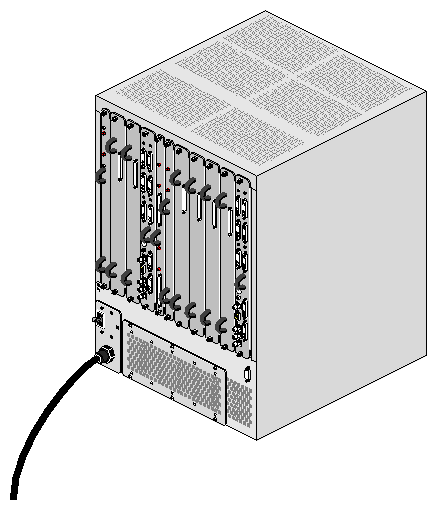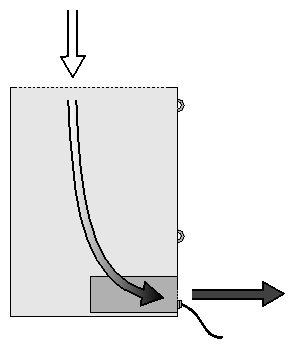The Onyx2 product line includes a rack version. The rack systems use one or more SGI 2000-series base modules (see “SGI 2000-Series Base Module Site Requirements” in Chapter 6) and one or more Onyx2 graphics insert modules (described in this chapter).
The Onyx2 graphics insert module (GIM), unlike the SGI 2000-series modules, may be used only in a rack chassis.
The Onyx2 graphics insert module is always mounted in a rack alone, with another Onyx2 graphics insert module, or with an SGI 2000-series base module.
Figure 7-1 shows a rear view of an Onyx2 graphics insert module.
Position the Onyx2 graphics insert module so that it receives proper air circulation. The airflow is in at the top of the chassis and out the fan at the bottom rear of the chassis, as shown in Figure 7-2. It is important that nothing block the areas shown by arrows. Onyx2 graphics insert modules are always installed in rack chassis. To see the airflow in an Onyx2 rack chassis, refer to Figure 8-6.
Onyx2 graphics insert modules are designed for use in typical office computing environments: The air temperature should not fluctuate dramatically, air should circulate freely, and the location should be relatively dust free.
The Onyx2 graphics insert module is an insert chassis that is used only in rack systems. An Onyx2 graphics insert module may share a rack with another Onyx2 graphics insert module or with an SGI 2000-series base module, or may be alone in a rack.
For information about selecting a physical location for a rack system containing an Onyx2 graphics insert module, see “Selecting a Location for an SGI 2000-Series, Origin Peripherals, or Onyx2 Rack System” in Chapter 8.
Table 7-1 lists the physical specifications of the Onyx2 graphics insert module.
Table 7-1. Onyx2 Graphics Insert Module Physical Specifications
Dimensions |
|
|
Installed: | length | 19.9” (50.5 cm) |
Shipping: | length | 30.9” (80 cm) |
Weight: | minimum | 125 lbs (56.7 kg) |
Air Temperature |
|
|
Operating: | 0-5,000 ft | 41° to 95° F (5° to 35° C) |
Non-Operating: |
| -4° to 140° F (-20° to 60° C) |
Thermal Gradient: | maximum | 18° F (10° C) per hour |
Altitude: | operating | 10,000 ft (3,048 m) MSL, maximum |
Relative Humidity: | operating | 10-90% (non-condensing) |
Humidity Gradient: | maximum | 10% relative humidity per hour |
Acoustics: | typical | 65 dBa |
Onyx2 graphics insert modules require 208 volt power (see “Voltage Requirements” in Chapter 2) and have a fixed power cable that plugs directly into wall power, rather than plugging into the rack PDU. This is different from Onyx2 and Origin2000 modules, which plug into the rack PDU.
| Warning: Any difference in ground potential greater than 500 millivolts (0.5 volts) between two chassis connected with CrayLink or XTown cables can cause a range of problems, from poor system operation to severe equipment damage. See “Chassis Branch Circuit Grounding” in Appendix B for further information. |
Table 7-2 provides power consumption and required cooling capacity information for the Onyx2 graphics insert modules. For formulas, descriptions, and general information about power and cooling, refer to “ Electrical Requirements” in Chapter 2 and “ Thermal Requirements” in Chapter 2.
| Caution: Onyx2 systems are highly configurable, and therefore have a wide range of power and cooling requirements. It is very rare for an Onyx2 graphics insert module to reach the “maximum” power and cooling requirements listed in Table 7-2. Ask your SGI representative about particular configurations. |
Table 7-2. Onyx2 Graphics Insert Module Power and Cooling Specifications
Volts: |
| 200-240 volts AC, 1-phase |
Watts (from the wall): | typical | 1,200 watts |
Power Factor: | minimum | 0.98 |
Total Harmonic Dist.: | maximum | 5% |
Inrush Current: | peak | 80 amps |
Frequency: |
| 47-53 Hertz |
Cooling Requirements: | typical | 4,092 Btu/hr (0.34-ton AC load) |
Airflow Volume: | maximum | 400 cfm (0.188 m3/s) |
See Appendix B, “Site Power and Power Cables”, for information about graphics insert module site-wiring and power cables.
Onyx2 graphics insert modules are typically connected to one or more monitors. See “Monitors” in Appendix A for more information.

